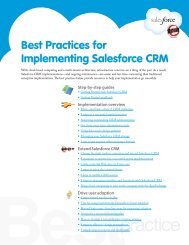Database.com Metadata API Developer's Guide - Salesforce.com
Database.com Metadata API Developer's Guide - Salesforce.com
Database.com Metadata API Developer's Guide - Salesforce.com
Create successful ePaper yourself
Turn your PDF publications into a flip-book with our unique Google optimized e-Paper software.
GlossaryRelationship QueryIn a SOQL context, a query that traverses the relationships between objects to identify and return results. Parent-to-childand child-to-parent syntax differs in SOQL queries.Role HierarchyA record-level security setting that defines different levels of users such that users at higher levels can view and editinformation owned by or shared with users beneath them in the role hierarchy, regardless of the organization-widesharing model settings.Roll-Up Summary FieldSSaaSA field type that automatically provides aggregate values from child records in a master-detail relationship.See Software as a Service (SaaS).<strong>Salesforce</strong> Record IDA unique 15- or 18-character alphanumeric string that identifies a single record in <strong>Database</strong>.<strong>com</strong>.<strong>Salesforce</strong> SOA (Service-Oriented Architecture)A powerful capability of Force.<strong>com</strong> that allows you to make calls to external Web services from within Apex.Session IDAn authentication token that is returned when a user successfully logs in to <strong>Database</strong>.<strong>com</strong>. The Session ID prevents auser from having to log in again every time he or she wants to perform another action in <strong>Database</strong>.<strong>com</strong>. Different froma record ID or <strong>Database</strong>.<strong>com</strong> ID, which are terms for the unique ID of a <strong>Database</strong>.<strong>com</strong> record.Session TimeoutSharingThe period of time after login before a user is automatically logged out. Sessions expire automatically after a predeterminedlength of inactivity, which can be configured in <strong>Database</strong>.<strong>com</strong> from Setup by clicking Security Controls. The defaultis 120 minutes (two hours). The inactivity timer is reset to zero if a user takes an action in the Web interface or makesan <strong>API</strong> call.Allowing other users to view or edit information you own. There are different ways to share data:• Sharing Model—defines the default organization-wide access levels that users have to each other’s information andwhether to use the hierarchies when determining access to data.• Role Hierarchy—defines different levels of users such that users at higher levels can view and edit information ownedby or shared with users beneath them in the role hierarchy, regardless of the organization-wide sharing model settings.• Sharing Rules—allow an administrator to specify that all information created by users within a given group or roleis automatically shared to the members of another group or role.• Manual Sharing—allows individual users to share records with other users or groups.• Apex-Managed Sharing—enables developers to programmatically manipulate sharing to support their application’sbehavior. See Apex-Managed Sharing.Sharing ModelBehavior defined by your administrator that determines default access by users to different types of records.Sharing RuleType of default sharing created by administrators. Allows users in a specified group or role to have access to all informationcreated by users within a given group or role.185
















